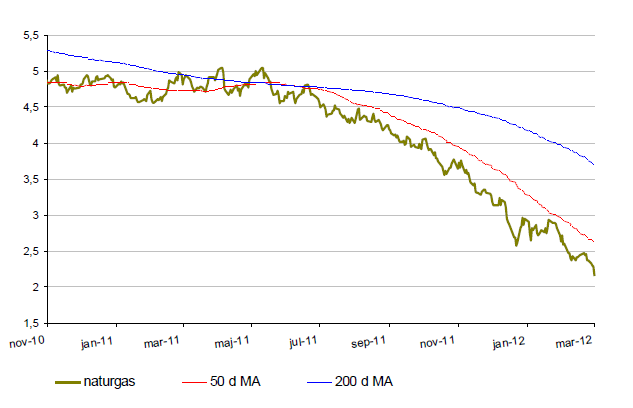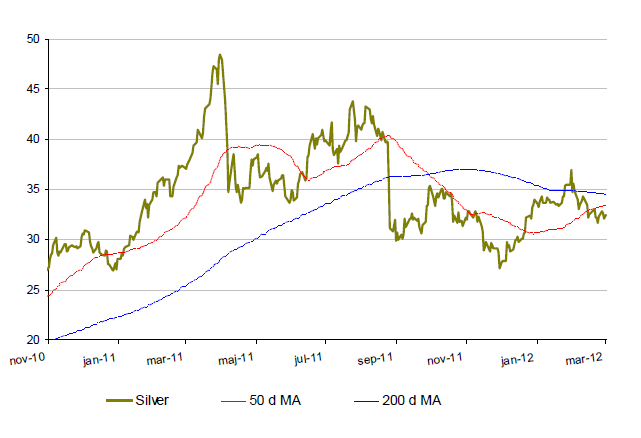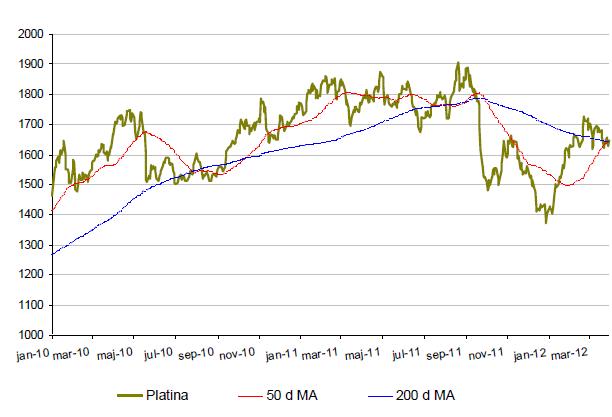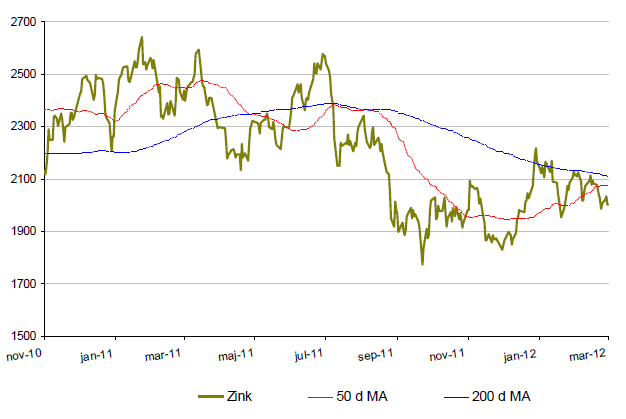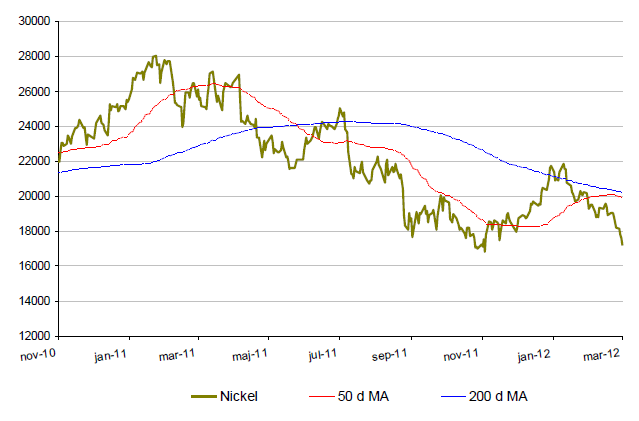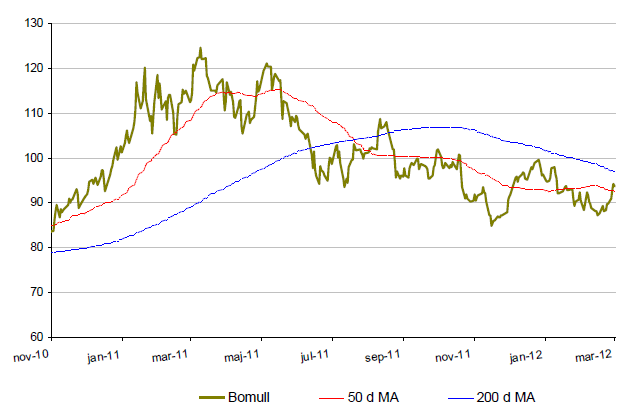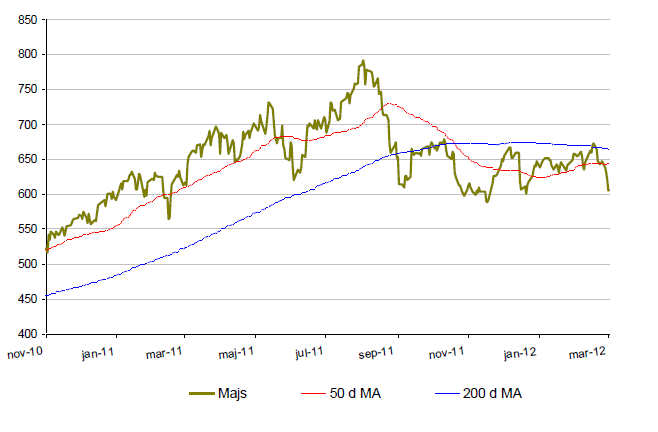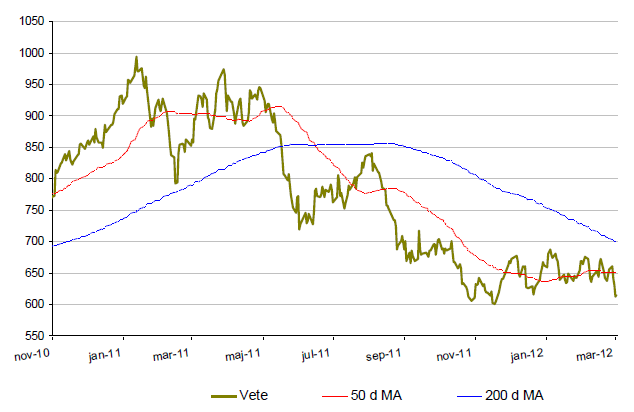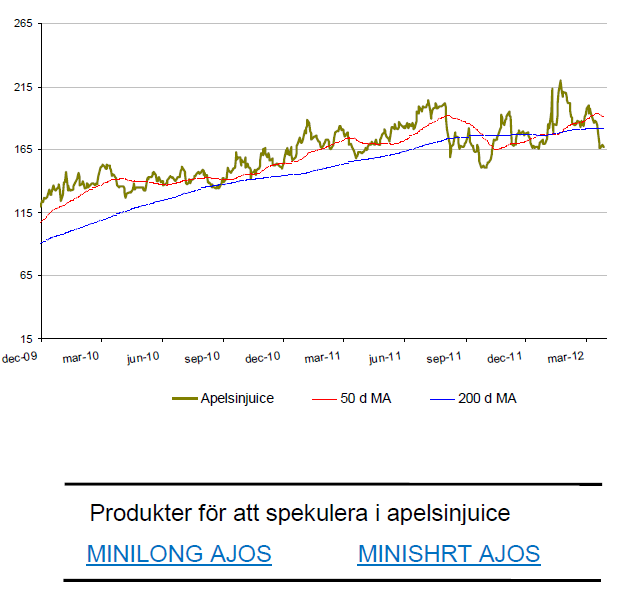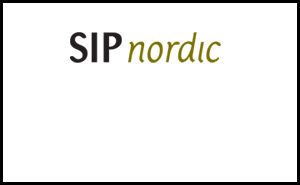Analys
SIP Nordic – Råvaruguiden – April 2012
 Råvaror + aktier blir inte råvaruaktier
Råvaror + aktier blir inte råvaruaktier
Det senaste decenniets uppgång i råvaror har fått investerare att söka sig mot tillgångsslaget. Många vill på något sätt inkludera råvaror i sin portfölj.
Jag är av den tron att en väl sammansatt portfölj bör innehålla en portion råvaror. Hur mycket är upp till var och en att anpassa efter sin riskprofil. Jag anser också att en råvaruexponering bör vara mot råvaror och inget annat. Här skriker nog många till men låt mig förklara.
Det finns många sätt att teoretiskt sett få exponering mot råvaror. Råvaruproducerande länder, såsom Brasilien och Ryssland, kan vara ett sätt att ta del av råvaruprisernas rörelse men det förutsätter ett politiskt, ekonomiskt system som låter intäkterna från råvaror att komma ut i ekonomin. Om detta är verklighet för de två nämnda länderna låter jag vara osagt. Det vanligaste sättet, men också det felaktiga sättet, är investeringar i råvaruaktier. Vad man måste komma ihåg är att investeringar i t.ex. Boliden eller Lundin Mining medför bolagsrisk. Kostnaden för utvinning av många råvaror är i dagsläget mycket högt och pressar vinsterna och lägg också därtill att många råvarubolag verkar i länder med instabila legala system så förstår ni nog var jag vill komma. Råvaruaktier ger, enligt mig, inte en ren exponering mot en viss råvara.
För ett par år sedan stod BP för den största oljekatastrofen i petroleumindustrins historia. Under tre månader flödade olja ut i Mexikanska golfen efter att oljeplattformen Deepwater horizon exploderat. Aktien tappade närmare 60% på väldigt kort tid. Samtidigt som WTI-oljan ”bara” tappade 10%.
Det är en underdrift att säga att den person som investerade i BP för att skapa sig en oljeexponering hade en otrolig otur.
På samma sätt som att oljeinvesteraren hade otur med BP så kan man föra samma resonemang med Lundin Petroleum under hösten 2011. LUPE:s stora fynd av råolja i höstas var för bolaget en supergrej men för brent-oljans pris betydde det ingenting. Oljefyndet skulle räcka till ca 20 dagars global konsumtion.
Det får därmed anses att den person som köpte LUPE för att skapa sig en oljeexponering hade ren och skär bondröta.
Det är viktigt att poängtera att jag inte lägger någon vikt huruvida BP och LUPE är bra bolag som kan genererar avkastning för investeraren. Kontentan är istället att råvaror + aktier inte resulterar i råvaruaktier.
Är ni intresserade av råvaror. Investera då i råvaran och inte aktier.
Råvaror – Energi
Brent olja
- Olja har efter en trevande start i januari både återhämtat sig och nått upp till nya höga nivåer under mars.
- Olja är upp ca.16% upp för året.
- Sedan i början av mars konsoliderar oljan i en kanal mellan 122 och 127 dollar.
- Trots rapporter om ökad tillgång och högre produktion, kyls inte oljepriset ned. Oron i Iran och OPEC länderna bidrar till att oljan behåller sin höga kurs.
- Libyens oljeproduktion börjar smått trappas upp. OPEC ländernas förutspådda produktion för 2012 har däremot sänkts.
Naturgas
- Naturgas närmar sig nu historiskt låga nivåer. Så pass låga att naturgas nu är nere på tio årslägsta.
- De varma temperaturerna i USA vi tidigare skrivit om fortsätter vilket pressar priset på naturgas.
- Naturgas har under året tappat nästan 30%.
- Det låga priset kan tvinga producenter att trappa ned på produktionen vilket kan hjälpa priset på naturgas positivt.
Råvaror – Metaller
Guld
- Summan av världens centralbanker guldpositioner har för första gången på två decennier gått från kort till lång position (spekulerar i uppgång). Detta talar för att guldpriset kan stabilisera sig kring nuvarande nivåer.
- Analytiker tror att centralbankernas guldköp kommer att fortsätta under hela 2012. Totalt räknar analytikerna att centralbanker kommer köpa motsvarande 300 ton guld till under 2012.
- Guld fortsätter att svänga kraftigt men har ökat med ca. 6% för året.
Silver
- Silver har tappat nästan 15% sedan början av Mars men handlas fortfarande på höga nivåer.
- För året är silver upp ca. 19% men har ännu $18 kvar till de höga noteringarna i april förra året.
- Silver befinner sig trots uppgången i en långsiktigt fallande kil.
- Tillgången på fysiskt silver spås minska med 1,5% under 2012 samtidigt som efterfrågan spås öka med 3%
Platina
- Platina har med sin uppgång på ca. 19% för året återhämtat sig rejält och handlas nu på ungefär samma nivåer som guldet.
- Normalt brukar Platinapriset ligga några hundra dollar över guldpriset.
- Strejken i Impala Rustenburg gruvorna i Syd- Afrika, världens största platina gruva, tog slut i mars med det kommer ta tid innan produktionen återgår till det normala.
- Bilindustrin står för den största industriella efterfrågan på platina. Med en stabilare utsikt för bilindustrin följer även högre platinapris.
Koppar
- Koppar har börjat året starkt efter ett ur svagt 2011. Koppar har gått upp ca. 12% i år. (Att jämföra med -21% under 2011)
- Under mars månad har dock kopparpriset stagnerat och konsoliderar nu mellan 8200 och 8750.
- Koppar inventarierna ligger nu på mycket låga nivåer.
- Dagens inventarier räcker enbart i drygt tre veckor. Detta anses oroande då kopparmarknaden behöver en buffert mot produktionsstopp såsom strejken i Freeports gruva i Grasberg i slutet av 2011.
Zink
- Likt koppar har zinkpriset kraftigt stigit under den första månaden av 2012. Zink är upp ca. 7% för året.
- Zinkprisets har dock under mars månad fallit 5% till följd av en mer sund balas i tillgång och efterfrågan.
- Den årliga konsumtionen av zink förväntas växa med 3.6% samtidigt som tillgången bara förväntas växa med 3%. Det uppskattas dock att nuvarande zinktillgång skulle räcka 7,5 veckor, 0,5 veckor längre än 2011.
Nickel
- Nickel presterade sämst av alla basmetaller under 2011.
- Nickel fortsätter sin kräftgång under 2012. Efter en uppgång i januari tappade nickel närmare 18% under februari och mars och är nu den enda basmetallen som inte utvecklats positivt under 2012.
- Produktionen väntas överstiga konsumtionen under 2012.
- Mängden utvunnet nickel förväntas stiga med närmare 10% under 2012.
- Trots att tillgången ökar behöver inte nickelpriset falla. Riskaptiten ökar även bland investerare vilket kan driva råvarupriserna mot högre höjder.
Råvaror – Jordbruk
Socker
- Socker är upp nästan 5% under 2012. Till en följd av dåliga och torra väderförhållandena i världens största sockerproducerande land, Brasilien.
- Det stigande oljepriset har under 2012 driitr sockerpriset uppåt. Då oljepriset ökar ökar även produktionen av etanol, vilket framställs av bland annat sockerrör.
- Sockerpriset hålls dels också kvar på dessa nivåer till följd av en stor order av socker senare i vår. Iran planerar att köpa en stor mängd socker av Indien.
Bomull
- Bomull är för året upp knappa 2%.
- Under 2012 har säljarna kopplat greppet om bomull.
- Det mest troliga att säljarna är i övervikt är att marknadens prognos visar på ett överflöd av bomull och vi ser nu rekordlager av råvaran.
- Viktig nivå för uppgång är $100/lb.
- Extrem torka i USA och ökad efterfrågan av bomullsimport från Kina kompenseras mer än väl av stora skördar i Indien och Brasilien.
Majs
- Prognoser av USDA:s kommande lagerstatistik visar att lagret av majs kommer att sjunka kraftigt.
- USDA justerade, i början av året, ned sin prognos för den Argentinska skörden. Från tidigare 29 miljoner ton till 26 miljoner ton. Nu ser det ut som att dåliga väderförhållanden fortsatt kan sätta käppar i hjulet för den argentinska skörden.
- Majs har för året gått ned nästan 5% och pendlar fortfarande mellan 580 och 680 cent.
Vete
- Likt majs väntar marknaden på USDA:s kommande lagerstatistik.
- Vete har för året gått ned runt 3% till följd av prognoser av bra lagerstatistik men också prognoser av att årets skörd väntas vara av bättre kvalitet än förra året.
- Nettopositionen, dvs summan av köpare och säljare, är fortsatt negativ. Säljarna har alltså fortfarande grepp om vetet.
Apelsinjuice
- Apelsinjuice har under mars månad tappat mer än 11%
- Det finns fortfarande fallhöjd i kursen då apelsinjuice har stigit med nästan 180% sedan 2009.
- Skörden spås dock bli väldigt god i Florida samtidigt som rapporter visar att efterfrågan på apelsinjuice minskar vilken kyler av priset.
- Skörden för året spås bli mycket högre än förra året.
[box]Denna uppdatering är producerat av SIP Nordic och publiceras i samarbete och med tillstånd på Råvarumarknaden.se[/box]
Ansvarsbegränsning
Detta produktblad utgör endast marknadsföring och har sammanställts av SIP Nordic Fondkommission AB.
Innehållet ger inte fullständig information avseende det finansiella instrumentet. Investerare uppmanas att del av prospekt och slutliga villkor, vilka finns tillgängliga på: www.rbsbank.se/markets, innan ett investeringsbeslut tas.
Förekommande exempel är simulerade och baseras på SIP Nordics egna beräkningar och antaganden, en person som använder andra data eller antaganden kan nå andra resultat. Administrativa avgifter och transaktionsavgifter påverkar den faktiska avkastningen.
Analys
A muted price reaction. Market looks relaxed, but it is still on edge waiting for what Iran will do

Brent crossed the 80-line this morning but quickly fell back assigning limited probability for Iran choosing to close the Strait of Hormuz. Brent traded in a range of USD 70.56 – 79.04/b last week as the market fluctuated between ”Iran wants a deal” and ”US is about to attack Iran”. At the end of the week though, Donald Trump managed to convince markets (and probably also Iran) that he would make a decision within two weeks. I.e. no imminent attack. Previously when when he has talked about ”making a decision within two weeks” he has often ended up doing nothing in the end. The oil market relaxed as a result and the week ended at USD 77.01/b which is just USD 6/b above the year to date average of USD 71/b.

Brent jumped to USD 81.4/b this morning, the highest since mid-January, but then quickly fell back to a current price of USD 78.2/b which is only up 1.5% versus the close on Friday. As such the market is pricing a fairly low probability that Iran will actually close the Strait of Hormuz. Probably because it will hurt Iranian oil exports as well as the global oil market.
It was however all smoke and mirrors. Deception. The US attacked Iran on Saturday. The attack involved 125 warplanes, submarines and surface warships and 14 bunker buster bombs were dropped on Iranian nuclear sites including Fordow, Natanz and Isfahan. In response the Iranian Parliament voted in support of closing the Strait of Hormuz where some 17 mb of crude and products is transported to the global market every day plus significant volumes of LNG. This is however merely an advise to the Supreme leader Ayatollah Ali Khamenei and the Supreme National Security Council which sits with the final and actual decision.
No supply of oil is lost yet. It is about the risk of Iran closing the Strait of Hormuz or not. So far not a single drop of oil supply has been lost to the global market. The price at the moment is all about the assessed risk of loss of supply. Will Iran choose to choke of the Strait of Hormuz or not? That is the big question. It would be painful for US consumers, for Donald Trump’s voter base, for the global economy but also for Iran and its population which relies on oil exports and income from selling oil out of that Strait as well. As such it is not a no-brainer choice for Iran to close the Strait for oil exports. And looking at the il price this morning it is clear that the oil market doesn’t assign a very high probability of it happening. It is however probably well within the capability of Iran to close the Strait off with rockets, mines, air-drones and possibly sea-drones. Just look at how Ukraine has been able to control and damage the Russian Black Sea fleet.
What to do about the highly enriched uranium which has gone missing? While the US and Israel can celebrate their destruction of Iranian nuclear facilities they are also scratching their heads over what to do with the lost Iranian nuclear material. Iran had 408 kg of highly enriched uranium (IAEA). Almost weapons grade. Enough for some 10 nuclear warheads. It seems to have been transported out of Fordow before the attack this weekend.
The market is still on edge. USD 80-something/b seems sensible while we wait. The oil market reaction to this weekend’s events is very muted so far. The market is still on edge awaiting what Iran will do. Because Iran will do something. But what and when? An oil price of 80-something seems like a sensible level until something do happen.
Analys
Very relaxed at USD 75/b. Risk barometer will likely fluctuate to higher levels with Brent into the 80ies or higher coming 2-3 weeks

Brent rallied 12% last week. But closed the week below USD 75/b and it is still there. Very relaxed. Brent crude rallied 12% to USD 78.5/b in the early hours of Friday as Israel attacked Iran. The highest level since 27 January this year. The level didn’t hold and Brent closed the day at USD 74.23/b which was up 5.7% on the day and 11.7% on the week. On Friday it was still very unclear how extensive and lasting this war between Iran and Israel would be. Energy assets in Iran had still not been touched and Iran had not targeted other Middle East countries’ energy assets or US military bases in the region. As such, the Brent crude closed the week comfortably at around USD 75/b. Which one cannot argue is very much of a stressed price level.

Israel is targeting Iran’s domestic energy infrastructure. Not its energy export facilities. For now. Over the weekend Israel has widened its targets to include fuel depots in Tehran, refineries supplying Iran domestically and also a processing plant at Iran’s South Pars gas field – the world’s largest. So far it appears that Israel has refrained from hurting Iranian oil and gas export facilities. Maybe adhering to Trump’s whish of low oil prices. Trump has been begging for a lower oil price. Would be very frustrating for him if Israel started to blow up Iran’s export facilities. Focus instead looks to be on Iran’s domestic energy supply and infrastructure. To weaken and disable the operations of Iran as a country while leaving Iran’s energy export facilities intact for now at least. That is probably why Brent crude this morning is only trading at USD 74.9/b with little change from Friday. An incredible relaxed price level given what is going on in the Middle East.
Israel seems to try to do to Iran what Israel recently did to Lebanon. Israel now seems to have close to total control of the Iranian air space. So called ”Air Supremacy” something which is rarely achieved according to Phillips P. O’Brian (see comment on this below with link). This is giving Israel close to total freedom in the airspace over Iran. Israel now seems to try to do to Iran what Israel recently did to Lebanon. Take out military and political commanders. Take out the air defenses. Then grind the rest of its defensive capacities to the ground over some time.
Continuous pressure. No rest. No letting up for several weeks seems likely. The current situation is a very rare opportunity for Israel to attack Iran with full force. Hamas in Gaza, Hezbollah in Lebanon, Iranian strongholds in Syria, are all severely weakened or disabled. And now also Air Supremacy of the airspace over Iran. It is natural to assume that Israel will not let this opportunity pass. As such it will likely continue with full force over several weeks to come, at least, with Israel grinding down the rest of Iran’s defensive capabilities and domestic energy supply facilities as far as possible. Continuous pressure. No rest. No letting up.
What to do with Fordow? Will Iran jump to weapons grade uranium? The big question is of course Iran’s nuclear facilities. Natanz with 16,000 enrichment centrifuges was destroyed by Israel on Friday. It was only maximum 20 meters below ground. It was where Iran had mass enrichment to low enrichment levels. Fordow is a completely different thing. It is 500 meters deep under a mountain. It is where enrichment towards weapons grade Uranium takes place. Iran today has 408 kg of highly enriched uranium (IAEA) which can be enriched to weapons grade. It is assumed that Iran will only need 2-3 days to make 25 kg of weapons grade uranium and three weeks to make enough for 9 nuclear warheads. How Israel decides to deal with Fordow is the big question. Ground forces? Help from the US?
Also, if Iran is pushed to the end of the line, then it might decide to enrich to weapons grade which again will lead to a cascade of consequences.
Brent is extremely relaxed at USD 75/b. But at times over coming 2-3 weeks the risk barometer will likely move higher with Brent moving into the 80ies or higher. The oil price today is extremely relaxed with the whole thing. Lots of OPEC+ spare capacity allows loss of Iranian oil exports. Israeli focus on Iran’s domestic energy systems rather than on its exports facilities is also soothing the market. But at times over the coming two, three weeks the risk barometer will likely move significantly higher as it might seem like the situation in the Middle East may move out of control. So Brent into the 80ies or higher seems highly likely in the weeks to come. At times at least. And if it all falls apart, the oil price will of course move well above 100.
Phillips P. OBrien on ”Air Supremacy” (embedded link): Air power historian Philip Meilinger: ”Air Superiority is defined as being able to conduct air operations “without prohibitive interference by the opposing force.” Air Supremacy goes further, wherein the opposing air force is incapable of effective interference.”
Thus, air supremacy is an entirely different beast from air superiority. It occurs when one power basically controls the skies over an enemy, and can operate practically anywhere/time that it wants without much fear of enemy interference in its operations.
The US had Air Supremacy over Germany in the second World War, but only at the very end when it was close to over. It only had Air Superiority in the Vietnam war, but not Supremacy. During Desert Storm in 1990-1991 however it did have Supremacy with devastating consequences for the enemy. (last paragraph is a condensed summary).
Analys
Brent needs to fall to USD 58/b to make cheating unprofitable for Kazakhstan

Brent jumping 2.4% as OPEC+ lifts quota by ”only” 411 kb/d in July. Brent crude is jumping 2.4% this morning to USD 64.3/b following the decision by OPEC+ this weekend to lift the production cap of ”Voluntary 8” (V8) by 411 kb/d in July and not more as was feared going into the weekend. The motivation for the triple hikes of 411 kb/d in May and June and now also in July has been a bit unclear: 1) Cheating by Kazakhstan and Iraq, 2) Muhammed bin Salman listening to Donald Trump for more oil and a lower oil price in exchange for weapons deals and political alignments in the Middle East and lastly 3) Higher supply to meet higher demand for oil this summer. The argument that they are taking back market share was already decided in the original plan of unwinding the 2.2 mb/d of V8 voluntary cuts by the end of 2026. The surprise has been the unexpected speed with monthly increases of 3×137 kb/d/mth rather than just 137 kb/d monthly steps.

No surplus yet. Time-spreads tightened last week. US inventories fell the week before last. In support of point 3) above it is worth noting that the Brent crude oil front-end backwardation strengthened last week (sign of tightness) even when the market was fearing for a production hike of more than 411 kb/d for July. US crude, diesel and gasoline stocks fell the week before last with overall commercial stocks falling 0.7 mb versus a normal rise this time of year of 3-6 mb per week. So surplus is not here yet. And more oil from OPEC+ is welcomed by consumers.
Saudi Arabia calling the shots with Russia objecting. This weekend however we got to know a little bit more. Saudi Arabia was predominantly calling the shots and decided the outcome. Russia together with Oman and Algeria opposed the hike in July and instead argued for zero increase. What this alures to in our view is that it is probably the cheating by Kazakhstan and Iraq which is at the heart of the unexpectedly fast monthly increases. Saudi Arabia cannot allow it to be profitable for the individual members to cheat. And especially so when Kazakhstan explicitly and blatantly rejects its quota obligation stating that they have no plans of cutting production from 1.77 mb/d to 1.47 mb/d. And when not even Russia is able to whip Kazakhstan into line, then the whole V8 project is kind of over.
Is it simply a decision by Saudi Arabia to unwind faster altogether? What is still puzzling though is that despite the three monthly hikes of 411 kb/d, the revival of the 2.2 mb/d of voluntary production cuts is still kind of orderly. Saudi Arabia could have just abandoned the whole V8 project from one month to the next. But we have seen no explicit communication that the plan of reviving the cuts by the end of 2026 has been abandoned. It may be that it is simply a general change of mind by Saudi Arabia where the new view is that production cuts altogether needs to be unwinded sooner rather than later. For Saudi Arabia it means getting its production back up to 10 mb/d. That implies first unwinding the 2.2 mb/d and then the next 1.6 mb/d.
Brent would likely crash with a fast unwind of 2.2 + 1.6 mb/d by year end. If Saudi Arabia has decided on a fast unwind it would meant that the group would lift the quotas by 411 kb/d both in August and in September. It would then basically be done with the 2.2 mb/d revival. Thereafter directly embark on reviving the remaining 1.6 mb/d. That would imply a very sad end of the year for the oil price. It would then probably crash in Q4-25. But it is far from clear that this is where we are heading.
Brent needs to fall to USD 58/b or lower to make it unprofitable for Kazakhstan to cheat. To make it unprofitable for Kazakhstan to cheat. Kazakhstan is currently producing 1.77 mb/d versus its quota which before the hikes stood at 1.47 kb/d. If they had cut back to the quota level they might have gotten USD 70/b or USD 103/day. Instead they choose to keep production at 1.77 mb/d. For Saudi Arabia to make it a loss-making business for Kazakhstan to cheat the oil price needs to fall below USD 58/b ( 103/1.77).
-

 Analys4 veckor sedan
Analys4 veckor sedanBrent steady at $65 ahead of OPEC+ and Iran outcomes
-

 Nyheter3 veckor sedan
Nyheter3 veckor sedanUSA slår nytt produktionsrekord av naturgas
-

 Analys4 veckor sedan
Analys4 veckor sedanAll eyes on OPEC V8 and their July quota decision on Saturday
-

 Nyheter2 veckor sedan
Nyheter2 veckor sedanStor uppsida i Lappland Guldprospekterings aktie enligt analys
-

 Nyheter3 veckor sedan
Nyheter3 veckor sedanBrookfield ska bygga ett AI-datacenter på hela 750 MW i Strängnäs
-

 Nyheter3 veckor sedan
Nyheter3 veckor sedanSommaren inleds med sol och varierande elpriser
-

 Nyheter3 veckor sedan
Nyheter3 veckor sedanOPEC+ ökar oljeproduktionen trots fallande priser
-

 Nyheter2 veckor sedan
Nyheter2 veckor sedanSilverpriset släpar efter guldets utveckling, har mer uppsida






